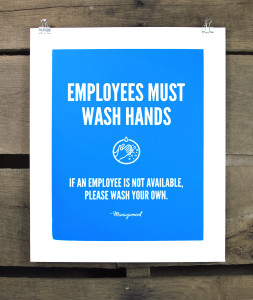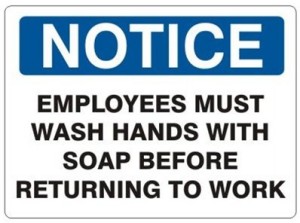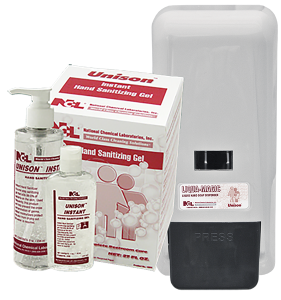Campaign for Clean Hands
We all know by now that one of the most important and simplest daily activities we can engage in is the routine washing of one’s hands. The statistics to support that statement from the Centers for Disease Control are staggering. A 31 percent decrease in the amount of people sick with diarrhea, 58 percent reduction in diarrhea in people with a weakened immune system, and a 16 to 21 percent reduction in contracting the common cold among the general population. But, yet, the percentage of those who wash their hands regularly remains below 100%.
Thus, the question begs to be asked, what will it take to get the remaining hold outs over to the sink and to start washing their hands. On the surface, some may ignore these numbers. In a position among those who are regular hand-washers, one may choose to ignore the staggering numbers of non-routine-hand washers, thinking it’s a personal healthcare issue that will not impact them. In reality it is imperative that we, the regular hand washers, do our best to convince the last hold outs to step up to the sink and lather up. While handwashing on the surface is a personal activity and habit, the ill effects of one not washing their hands quickly transforms itself from singular to collective.
All it takes is one individual in your workplace to not wash their hands after a restroom usage. That person then proceeds to spread their bacteria and other substances over multiple surfaces. Those surfaces are the common, every day surfaces that everyone touches with little thought given to their safety and health. Even though you and others in the majority have taken the steps to improve your health, that one individual who did not wash their hands has placed your facility’s staff, customers, and guests at risk of contracting one of the illnesses that you intended to prevent when you were last in the restroom, washing your hands.
Most people at least attempt to be cognizant of the surfaces they come in contact with which may pose a health risk, such as those in a restroom. However, the list is endless of common surfaces that we all touch without giving much thought. A simple object such as a filing cabinet drawer handle may not inspire the need for immediate hand washing, such as a toilet, but when someone uses the restroom without washing their hands and then opens a drawer on that filing cabinet, the same germs and bacteria found in the restroom are now on that drawer handle. When you or anyone else who touches that contaminated drawer handle next, it is like touching a restroom surface.
In this context, routine hand washing can no longer be interpreted as merely a personal health issue. Similar to breathing the second hand smoke from a cigarette smoker, the actions of one impacts the health of an entire group. Fortunately, convincing a non-hand washer to start washing their hands regularly should be easier than getting the smoker to cease an addictive activity and put the cigarettes out for good.
While there is no bona-fide, proven method to get people to wash their hands regularly with 100% accuracy, we have a few tips on different routes to take to improve the overall percentage of people in your facility (or home) to start washing on a regular basis and keeping everyone healthy.
CONVERT TO FOAMING HAND SOAPS
Foam soaps start out in the liquid form that many are accustomed to using in restrooms. Foaming dispensers infuse air into the product before the soap exits into someone’s hands. The result is a lather that is both light but luxurious. That texture increases the level of end-user acceptance. The added bonus in educational facilities is that school age children tend to prefer the unfamiliar, “new-school” foam to the customary, “old-school” liquid.
Facility managers around the country have already been switching from liquid to foam soaps at a high rate. The infused air decreases the amount of product needed per individual hand wash without losing effectiveness. From a maintenance standpoint, foam soaps present an advantage over liquid soaps since their light density decreases the likelihood of restroom drains clogging from soap residues. Foam soaps also will not drip from the dispenser on to the floor. That helps keep the restroom from appearing unkempt and not well maintained. People are more likely to wash their hands in a clean environment, while a dirty bathroom is likely to make people skip steps in order to escape the unsanitary conditions.
KEEP YOUR RESTROOM FACILITIES CLEAN
People are more likely to take the extra step and wash their hands in a clean and pleasant restroom environment. If a restroom is unkempt, malodorous, and just downright dirty, people will want to get in and get out as quick as possible. In the back of their minds they cannot see the equation between a dirty sink and clean hands. Unsanitary restroom facilities are two-pronged problem. For one, the conditions may dissuade someone from washing their hands, and two; they most likely will be in contact with more bacteria than they would in a sanitary restroom. While far from a cure-all for dirty restrooms, foaming hand soap does eliminate the chance of unwanted dripping out of the dispenser, causing a mess on the sink, counters, or floors.
UTILIZE SIGNAGE

Whether designed to be an attention-grabbing comical sign (above) or a straight to the point, serious sign (left), proper signage can bring about the desired result of more people at your facility regularly washing their hands.
Whether it is a small, subtle reminder in the restroom to wash hands or a large poster with short, concise facts to back up the value of regular hand washing, utilize these tools. It could be enough to get that person who is in a rush to stop for a minute and realize whatever it was they were in a rush for, could wait two minutes for them to properly wash their hands. The top of mind awareness that the signs create can go toward the development of a steady habit.
WELL PLACED SANITIZER STATIONS
Hand sanitizers are a great way to kill germs quickly, on the go, in areas where water is not readily available for conventional hand washing. However, the use of hand sanitizers should be used in conjunction with soap and water hand washing, not in place of it. Placing the sanitizer stations in highly visible, high traffic areas will encourage their use. Positioning the stations in highly visible areas will encourage peer pressure. No one wants to be the only one not protecting themselves against bacteria, germs, and disease.

Hand sanitizers can be offered either via well placed, public dispensers, or via personal size bottles
DAILY REMINDERS AT THEIR DESK
There are plenty of available statistics to support the call to action for everyone to start washing their hands on a routine basis. It is not uncommon for some HR departments to send out mass emails with reminders on a wide assortment of topics. If your facility is having an issue with a low hand washing rate among employees and a higher than usual amount of productivity lost due to employee sick days, then this may be subtle, yet aggressive tactic to get people thinking about their hand hygiene habits. A quick, daily “health tip” should include other health related topics to avoid the appearance of a single subject agenda. There are plenty of convincing statements available online to include in your company-wide emails. If you have difficulty finding one that suits your facility, please call our Technical Support hotline at 215-922-1200, ext. 261.
 English
English Español
Español


